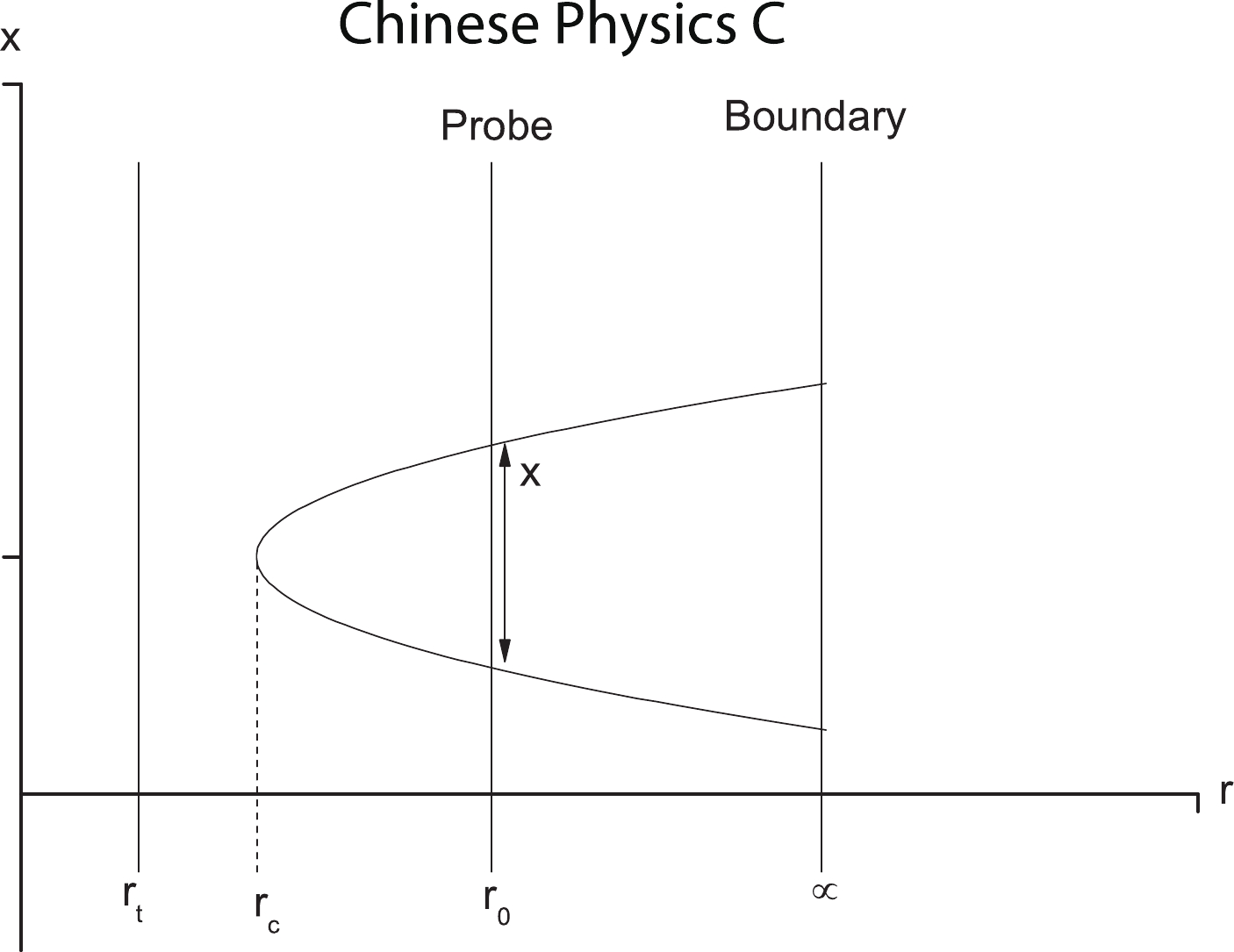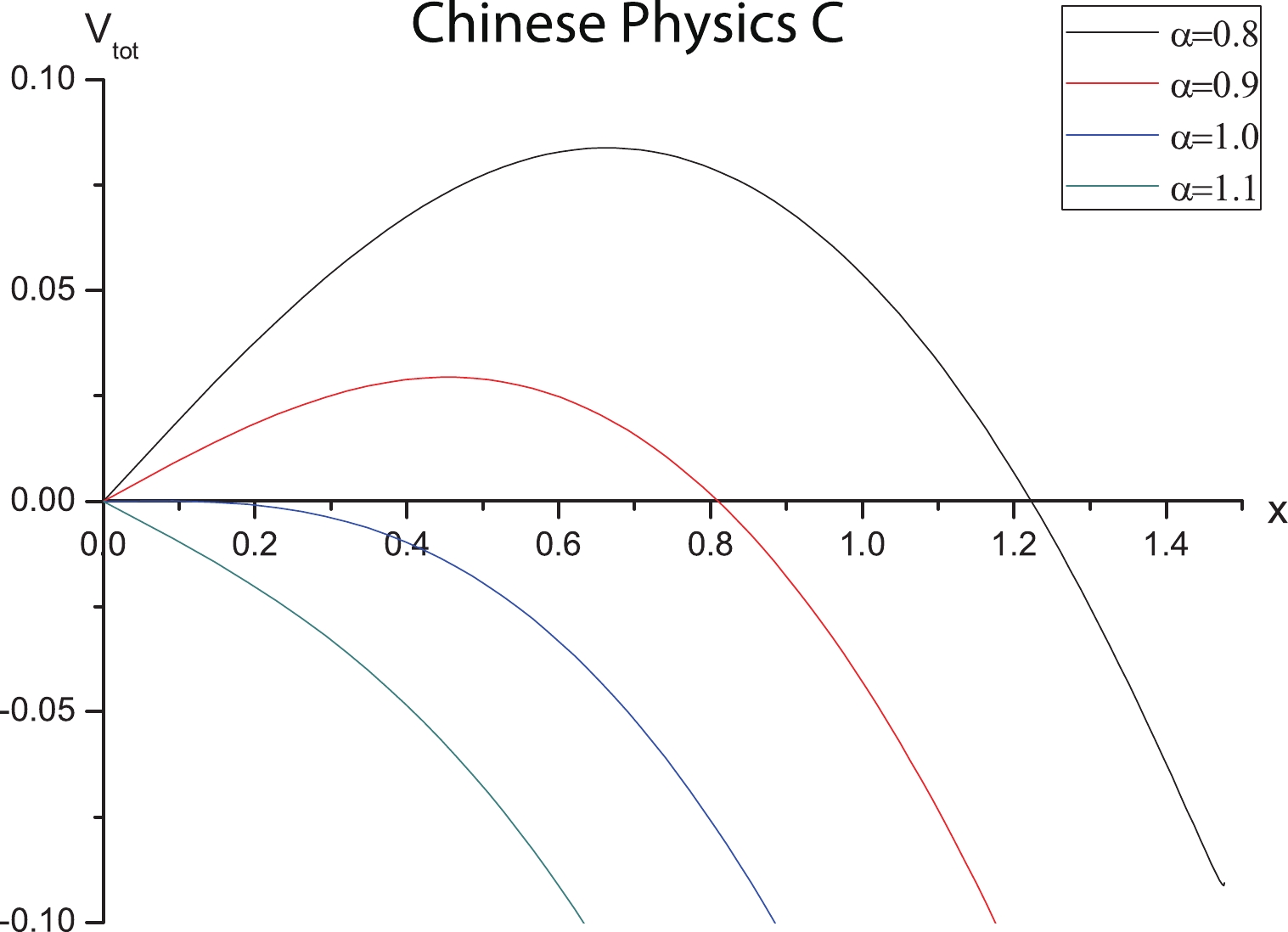HTML
--> --> --> $ \Gamma\sim \exp\left({\frac{-\pi m^2}{eE}}\right), $  | (1) |
$ \Gamma\sim \exp\left({\frac{-\pi m^2}{eE}+\frac{e^2}{4}}\right), $  | (2) |
In fact, the Schwinger effect is not unique to QED but is a universal aspect of quantum field theories (QFTs) coupled to a U(1) gauge field. However, it remains difficult to study this effect in a QCD-like manner or through a confining theory using QFTs because the (original) Schwinger effect must be non-perturbative. Fortunately, the AdS/CFT correspondence [3-5] may provide an alternative approach. In 2011, Semenoff and Zarembo proposed [6] a holographic setup to study the Schwinger effect based on the Higgsed
$ \Gamma\sim \exp\left[-\frac{\sqrt{\lambda}}{2}\left(\sqrt{\frac{E_c}{E}}-\sqrt{\frac{E}{E_c}}\right)^2\right], \qquad E_c = \frac{2\pi m^2}{\sqrt{\lambda}}, $  | (3) |
 Figure1.
Figure1. Herein, we present an alternative holographic approach to study the Schiwinger effect using potential analysis. As the motivation of this study, holographic QCD models, such as hard walls [25,26], soft walls [27], and some improved AdS/QCD models [28-34] have achieved considerable success in describing various aspects of hadron physics. In particular, we will adopt the SW
The outline of this paper is as follows. In the next section, we briefly review the SW
$ {\rm d}s^2 = \frac{R^2}{z^2}h(z)\left(-f(z){\rm d}t^2+{\rm d}\vec{x}^{\,2}+\frac{{\rm d}z^2}{f(z)}\right), $  | (4) |
$ f(z) = 1-(1+Q^2)\left(\frac{z}{z_h}\right)^4+Q^2\left(\frac{z}{z_h}\right)^6, \qquad h(z) = {\rm e}^{c^2z^2}, $  | (5) |
The temperature of the black hole is
$ T = \frac{1}{\pi z_h}\left(1-\frac{Q^2}{2}\right), \;\;\;\; 0\leqslant Q\leqslant \sqrt{2}. $  | (6) |
$ \begin{array}{l} \mu = \sqrt{3}Q/z_h. \end{array} $  | (7) |
The Nambu-Goto action is
$ S = T_F\int {\rm d}\tau {\rm d}\sigma{\cal L} = T_F\int {\rm d}\tau {\rm d}\sigma\sqrt{g}, \quad T_F = \frac{1}{2\pi\alpha^\prime}, $  | (8) |
$ g_{\alpha\beta} = g_{\mu\nu}\frac{\partial X^\mu}{\partial\sigma^\alpha} \frac{\partial X^\nu}{\partial\sigma^\beta}, $  | (9) |
Supposing the pair axis is aligned in one direction, e.g., the
$ \begin{array}{l} t = \tau, \;\;\; x_1 = \sigma, \;\;\; x_2 = 0,\;\;\; x_3 = 0, \;\;\; r = r(\sigma). \end{array} $  | (10) |
$ \begin{aligned}[b]& g_{00} = \frac{r^2h(r)f(r)}{R^2}, \\& g_{01} = g_{10} = 0, \\&g_{11} = \frac{r^2h(r)}{R^2}+\frac{R^2h(r)}{r^2f(r)}\left(\frac{{\rm d}r}{{\rm d}\sigma}\right)^2, \end{aligned} $  | (11) |
${\cal L} = \sqrt{M(r)+N(r)\left(\frac{{\rm d}r}{{\rm d}\sigma}\right)^2}, $  | (12) |
$ M(r) = \frac{r^4h^2(r)f(r)}{R^4},\qquad N(r) = h^2(r). $  | (13) |
$ {\cal L}-\frac{\partial{\cal L}}{\partial\left(\dfrac{{\rm d}r}{{\rm d}\sigma}\right)}\left(\dfrac{{\rm d}r}{{\rm d}\sigma}\right) = {\rm Constant}. $  | (14) |
$ \frac{{\rm d}r}{{\rm d}\sigma} = 0,\;\;\; r = r_c\;\;\; (r_t<r_c<r_0) , $  | (15) |
$ \frac{{\rm d}r}{{\rm d}\sigma} = \sqrt{\frac{M^2(r)-M(r)M(r_c)}{M(r_c)N(r)}} , $  | (16) |
 Figure2. Configuration of string world-sheet.
Figure2. Configuration of string world-sheet.Integrating (16) with the boundary condition (15), the following inter-distance of the particle pair is obtained:
$ x = 2\int_{r_c}^{r_0}\frac{{\rm d}\sigma}{{\rm d}r}{\rm d}r = 2\int_{r_c}^{r_0}{\rm d}r\sqrt{\frac{M(r_c)N(r)}{M^2(r)-M(r)M(r_c)}} . $  | (17) |
$ V_{CP+E} = 2T_F\int_{r_c}^{r_0}{\rm d}r\sqrt{\frac{M(r)N(r)}{M(r)-M(r_c)}}. $  | (18) |
$ S_{\rm DBI} = -T_{\rm D3}\int {\rm d}^4x\sqrt{-{\rm det}(G_{\mu\nu}+\mathcal{F}_{\mu\nu})} , $  | (19) |
$ T_{\rm D3} = \frac{1}{g_s(2\pi)^3\alpha^{\prime^2}}, \;\;\; \mathcal{F}_{\mu\nu} = 2\pi\alpha^\prime F_{\mu\nu}, $  | (20) |
The induced metric is
$ G_{00} = -\frac{r^2h(r)f(r)}{R^2}, \;\;\; G_{11} = G_{22} = G_{33} = \frac{r^2h(r)}{R^2}. $  | (21) |
$ \begin{array}{l} G_{\mu\nu}+\mathcal{F}_{\mu\nu} = \left( \begin{array}{cccc} -\dfrac{r^2h(r)f(r)}{R^2} & 2\pi\alpha^\prime E & 0 & 0\\ -2\pi\alpha^\prime E & \dfrac{r^2h(r)}{R^2} & 0 & 0 \\ 0 & 0 & \dfrac{r^2h(r)}{R^2} & 0\\ 0 & 0 & 0 & \dfrac{r^2h(r)}{R^2} \end{array} \right), \end{array} $  | (22) |
$ {\rm det}(G_{\mu\nu}+\mathcal{F}_{\mu\nu}) = \frac{r^4h^2(r)}{R^4}\left[(2\pi\alpha^\prime)^2E^2-\frac{r^4h^2(r)f(r)}{R^4}\right]. $  | (23) |
$ S_{\rm DBI} = -T_{\rm D3}\frac{r_0^2h(r_0)}{R^2}\int {\rm d}^4x \sqrt{\frac{r_0^4h^2(r_0)f(r_0)}{R^4}-(2\pi\alpha^\prime)^2E^2} , $  | (24) |
To avoid (24) being ill-defined, one should get
$ \frac{r_0^4h^2(r_0)f(r_0)}{R^4}-(2\pi\alpha^\prime)^2E^2\geqslant 0, $  | (25) |
$ E\leqslant T_F\frac{r_0^2h(r_0)}{R^2}\sqrt{f(r_0)}. $  | (26) |
$ E_c = T_F\frac{r_0^2h(r_0)}{R^2}\sqrt{f(r_0)}, $  | (27) |
Next, we calculate the total potential. For simplicity, we introduce the following dimensionless parameters
$ \alpha\equiv\frac{E}{E_c}, \;\;\; y\equiv\frac{r}{r_c},\;\;\; a\equiv\frac{r_c}{r_0},\;\;\; b\equiv\frac{r_t}{r_0}. $  | (28) |
$ \begin{aligned}[b] V_{\rm tot}(x) = &V_{CP+E}-Ex = 2ar_0T_F\int_1^{1/a}{\rm d}y\sqrt{\frac{A(y)B(y)}{A(y)-A(y_c)}}\\& - 2ar_0T_F\alpha \frac{r_0^2h(y_0)}{R^2}\sqrt{f(y_0)}\\&\times \int_1^{1/a} {\rm d}y\sqrt{\frac{A(y_c)B(y)}{A^2(y)-A(y)A(y_c)}}, \end{aligned} $  | (29) |
$ \begin{aligned}[b]& A(y) = \frac{(ar_0y)^4h^2(y)f(y)}{R^4},\quad A(y_c) = \frac{(ar_0)^4h^2(y_c)f(y_c)}{R^4},\\& B(y) = h^2(y) ,\quad h(y) = {\rm e}^{\textstyle\frac{c^2R^4}{(ar_0y)^2}},\\& f(y) = 1-\left(1+\frac{\mu^2R^4}{3r_t^2}\right)\left(\frac{b}{ay}\right)^4+\frac{\mu^2R^4}{3r_t^2}\left(\frac{b}{ay}\right)^6, \\& h(y_c) = {\rm e}^{\textstyle\frac{c^2R^4}{(ar_0)^2}},\quad f(y_c) = 1-\left(1+\frac{\mu^2R^4}{3r_t^2}\right)\left(\frac{b}{a}\right)^4+\frac{\mu^2R^4}{3r_t^2}\left(\frac{b}{a}\right)^6,\\ &h(y_0) = {\rm e}^{\textstyle\frac{c^2R^4}{r_0^2}},\quad f(y_0) = 1-\left(1+\frac{\mu^2R^4}{3r_t^2}\right)b^4+\frac{\mu^2R^4}{3r_t^2}b^6, \end{aligned} $  | (30) |
Before going further, we should discuss the value of
In Fig. 3, we plot
 Figure3. (color online)
Figure3. (color online) To see how the chemical potential modifies the Schwinger effect, we plot
 Figure4. (color online)
Figure4. (color online) In addition, we plot
 Figure5. (color online)
Figure5. (color online) Finally, to understand how the chemical potential and confining scale affect the critical electric field, we plot
 Figure6. (color online) Left:
Figure6. (color online) Left: However, there are some questions that need to be addressed further. First, the potential analysis is basically within the Coulomb branch, related to the leading exponent corresponding to the on-shell action of the instanton and not the full decay rate. In addition, the SW

